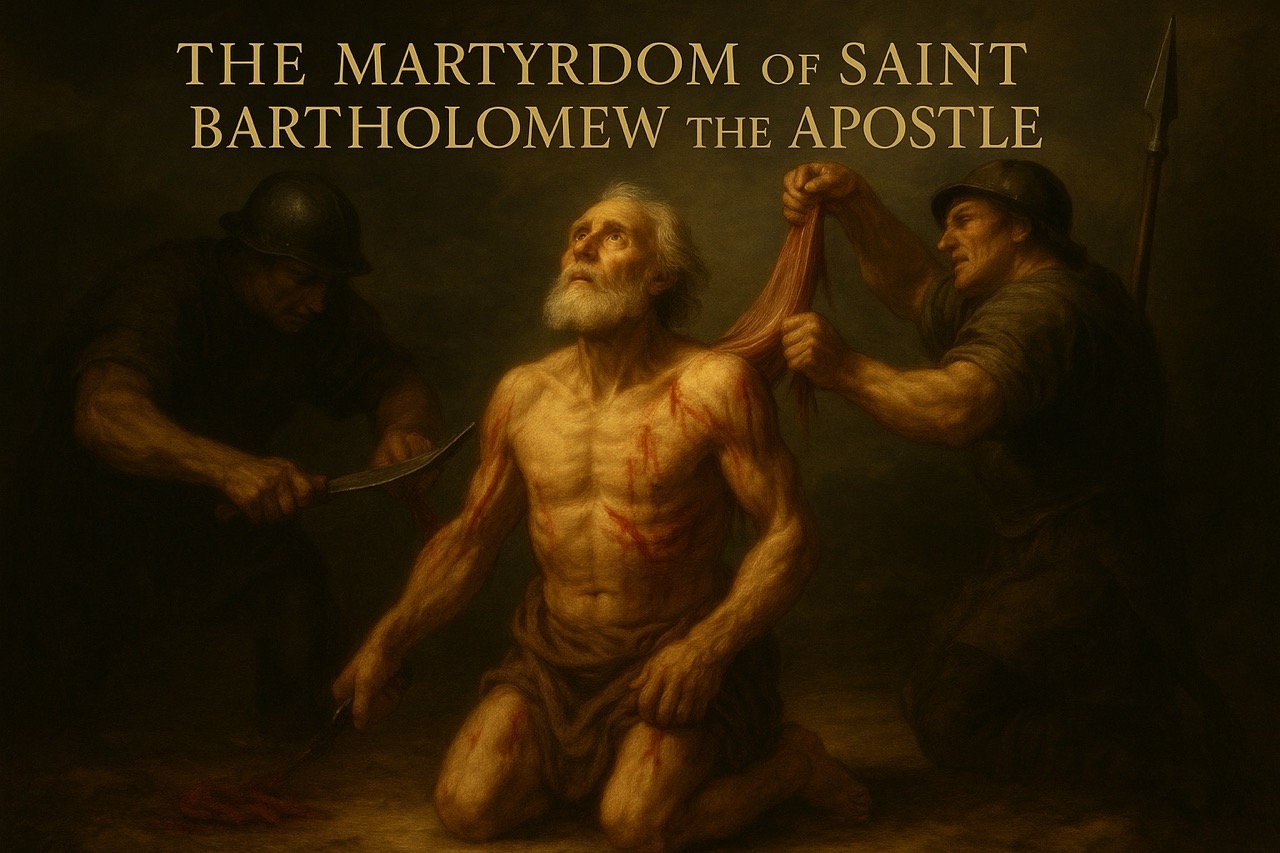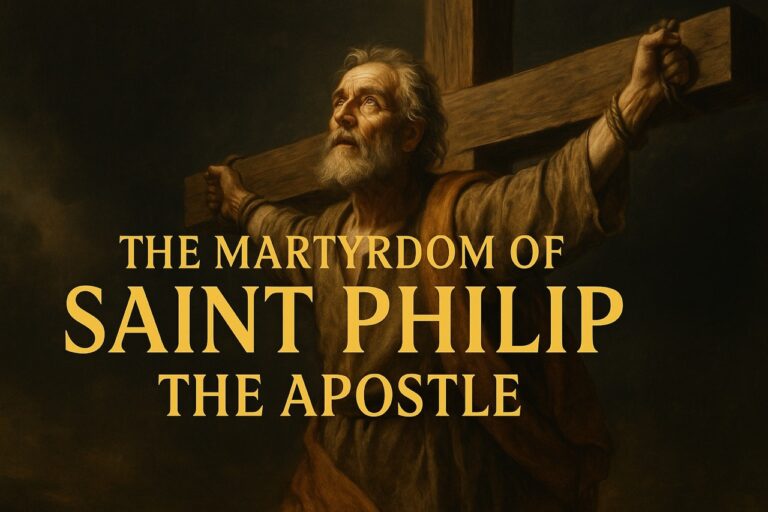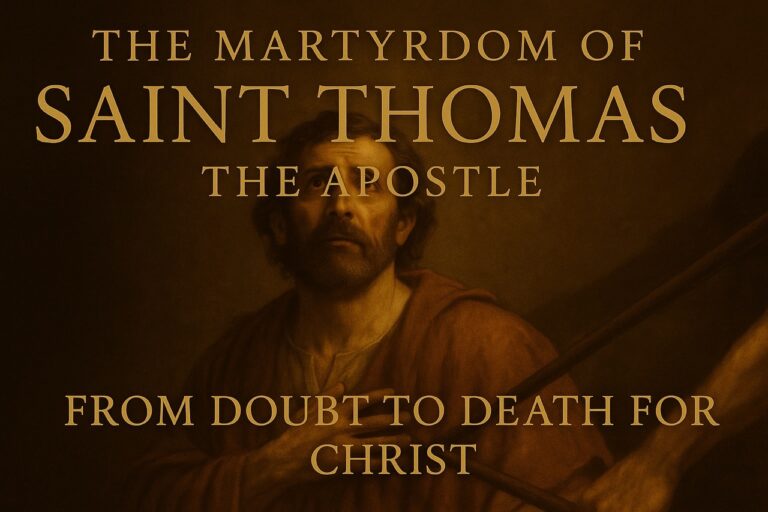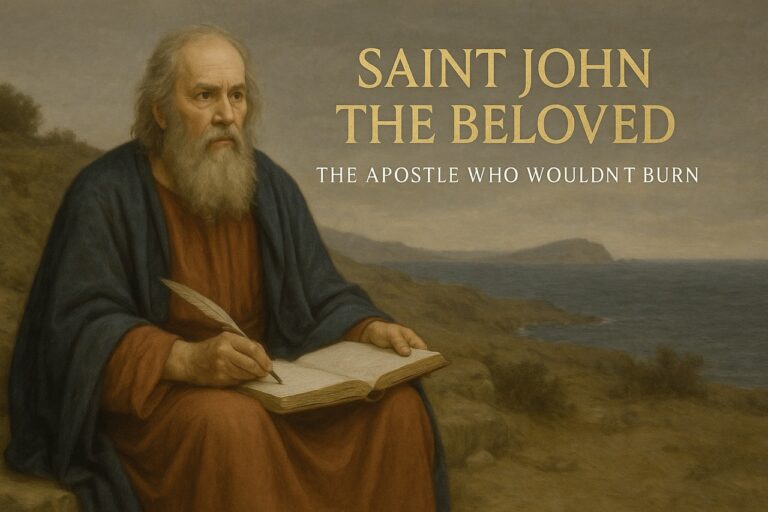The martyrdom of Saint Bartholomew remains one of the most gruesome accounts from the early church. Yet behind the violence stands a disciple marked by quiet faith, deep conviction, and fearless endurance. While others spoke loudly, he traveled quietly — far from the center of Jerusalem — carrying the Gospel to nations who had never heard the name of Jesus.
His life reminds us that true discipleship is not defined by popularity, but by perseverance. And his death demands that we ask: What kind of truth makes a man willing to be flayed alive?
📍 Who Was Saint Bartholomew?
Bartholomew, often identified with Nathanael, was one of the Twelve Apostles chosen by Jesus Himself. In the Gospel of John, Philip finds Nathanael and tells him, “We have found the one Moses wrote about in the Law, and about whom the prophets also wrote — Jesus of Nazareth, the son of Joseph” (John 1:45, NIV).
Nathanael responds skeptically:
“Nazareth! Can anything good come from there?” (John 1:46)
But Philip simply replies, “Come and see.”
When Jesus sees Nathanael approaching, He says:
“Here truly is an Israelite in whom there is no deceit.” (John 1:47)
Startled, Nathanael asks how Jesus knows him. Jesus answers,
“I saw you while you were still under the fig tree before Philip called you.” (John 1:48)
In that moment, Nathanael believes:
“Rabbi, you are the Son of God; you are the King of Israel.” (John 1:49)
Although Bartholomew is not mentioned by name in the Gospel of John, he is listed in every Synoptic Gospel (Matthew, Mark, and Luke) as one of the Twelve, always paired with Philip. Because Nathanael is absent from those lists, and Bartholomew is absent from John, most scholars believe they are two names for the same person — a common practice in the ancient world.
📖 Where Is Saint Bartholomew Found in Scripture?
Bartholomew appears in several key passages in the New Testament:
- Matthew 10:2–4 – “These are the names of the twelve apostles: first, Simon (who is called Peter)… Philip and Bartholomew…”
- Mark 3:16–19 – Bartholomew is again listed among the Twelve
- Luke 6:13–16 – His name is included in the calling of the apostles
- Acts 1:13 – After Jesus’ ascension, Bartholomew is present in the upper room, waiting for the Holy Spirit
If he is indeed Nathanael, he also features in:
- John 1:45–51 – Where Jesus calls him personally and praises his sincerity
- John 21:2 – After the resurrection, Nathanael is among those who witness the miraculous catch of fish at the Sea of Galilee
These passages place him at both the beginning and end of Jesus’ earthly ministry — a man faithful from first call to final commission.
⚔️ The Martyrdom of Saint Bartholomew the Apostle
After Jesus’ resurrection and the descent of the Holy Spirit at Pentecost, Bartholomew began an extended missionary journey. Early church traditions say he traveled to:
- India (likely southern Arabia or modern-day Pakistan)
- Persia and Mesopotamia
- Armenia, where he ultimately gave his life
While in Albanopolis (in modern-day Armenia or the Caucasus), Bartholomew boldly preached the Gospel and performed miracles. His ministry led many to faith — including the king’s sister, who converted and began to follow Christ. Enraged by this defiance of their gods, pagan priests and royal officials pressured the king to act.
They ordered a public execution. But this wasn’t an ordinary death.
Bartholomew was flayed alive — his skin cut from his body while he remained conscious — and then beheaded.
Ancient Christian texts that describe his martyrdom include:
- Foxe’s Book of Martyrs
- The Roman Martyrology
- The Golden Legend
- Orthodox and Armenian traditions
The violence was meant to terrify. Instead, it testified. His death proclaimed the Gospel with more power than his voice ever could.
🔪 Why Was Saint Bartholomew Flayed?
Flaying was a brutal form of execution used for criminals accused of treason, blasphemy, or sacrilege. Bartholomew’s preaching struck at the heart of both pagan religion and imperial control. He didn’t merely suggest Jesus was important — he declared that all idols were false and that Christ alone was King.
This was not a message they could tolerate.
- The priests felt exposed.
- The rulers felt threatened.
- The people were turning to Jesus.
And Bartholomew refused to stop.
He could have fled or recanted. Instead, he stayed. He chose pain over compromise — because he believed resurrection was real.
👁️ Why the Martyrdom of Saint Bartholomew Still Matters
Bartholomew’s death wasn’t just a sad end to a holy life. It was evidence.
He didn’t die for a parable.
Wasn’t tortured for a tradition.
He gave his body — because he had seen the risen Christ.
The apostles didn’t merely preach a message. They sealed it with their blood. No man allows his skin to be peeled from his body unless he’s convinced the tomb is empty.
Bartholomew’s martyrdom confirms this truth:
💡 The disciples were not deceived — they were transformed. And they chose death rather than deny what they knew.
📖 What We Learn from the Life of Saint Bartholomew
Bartholomew isn’t remembered for his eloquence.
He didn’t write a Gospel.
He didn’t perform dramatic signs in Jerusalem.
But he followed Jesus.
He went to the hard places.
He stayed when it hurt.
And he died with hope in his heart.
In a noisy world, Bartholomew reminds us:
Obedience is louder than words.
Faith doesn’t always go viral — but it always endures.
He laid down his life quietly…
And gained an eternal crown.
📚 Internal Related Reading
- The Martyrdom of Saint Philip the Apostle
Philip was crucified. Bartholomew was flayed. The Gospel didn’t bend. - The Martyrdom of Saint Thomas the Apostle
Doubt turned to courage. India became sacred ground. - The Martyrdom of Saint James the Greater
The first apostle to fall. His sword paved the way for others. - Peter’s Martyrdom: From Denial to Glory
From brokenness to boldness — the road leads to the cross. - The Martyrdom of Jesus’ Disciples
Twelve men. One truth. And a Gospel they would not deny. - Prophecies of Jesus’ Resurrection
They died because He rose. Their blood confirms it. - Historical Evidence of Jesus
From history to tombs — the story checks out.
🌐 External Related Reading
- Bartholomew the Apostle – Britannica
- The Flaying of Saint Bartholomew – Catholic Encyclopedia
- Martyrdom Accounts – Foxe’s Book of Martyrs (Archive)
🙋♂️ Frequently Asked Questions About the Martyrdom of Saint Bartholomew
📖 Life and Identity
❓ Was Saint Bartholomew the same as Nathanael in the Bible?
Yes, many biblical scholars believe Bartholomew and Nathanael were the same person. Nathanael appears in John’s Gospel (John 1:45–51) but is not listed among the Twelve Apostles. Meanwhile, Bartholomew is named in all the Synoptic lists but is absent from John. Since Bartholomew is consistently paired with Philip — who introduced Nathanael to Jesus — it’s widely accepted that these are two names for one disciple.
❓ Where did Saint Bartholomew preach after Jesus’ ascension?
Bartholomew carried the Gospel farther than most apostles. Tradition states he traveled to India, Persia, Mesopotamia, and eventually Armenia. In each region, he shared the message of Christ, converted many to the faith, and established churches among people who had never heard of Jesus.
✝️ Martyrdom and Death
❓ How did Saint Bartholomew die?
He was flayed alive and then beheaded. This brutal execution occurred in Armenia, where his ministry had caused many to abandon idol worship. According to ancient sources, his flaying was intended as a public spectacle to discourage conversion — but instead, it immortalized his testimony.
❓ Why was Bartholomew targeted for execution?
His bold preaching and miracles led to the conversion of numerous locals, including the king’s sister. This provoked outrage among pagan priests and royal officials. Seeing Christianity as a threat to their influence, they demanded his death. Bartholomew refused to stop proclaiming Christ, even when facing torture.
❓ Is there any historical evidence for the martyrdom of Saint Bartholomew?
While modern archaeology has not uncovered direct evidence of his death, the story of Bartholomew’s martyrdom appears across multiple independent sources. These include Foxe’s Book of Martyrs, the Roman Martyrology, Eastern Orthodox traditions, and early church writings. Their consistency across cultures and centuries adds weight to the tradition.
❓ What happened to his body after his death?
His remains were eventually transferred to Rome, where they are now enshrined at the Church of Saint Bartholomew on Tiber Island. Other regions, such as Benevento and Frankfurt, also claim to house some of his relics — a common practice in early Christianity.
🌍 Legacy and Theology
❓ What does Saint Bartholomew’s martyrdom prove about the apostles?
It confirms their total conviction. No one allows themselves to be flayed alive for a story they know is false. Bartholomew’s death — like the other apostles’ — demonstrates that they truly believed Jesus had risen from the dead. Their willingness to suffer proves their message wasn’t made up. It was witnessed.
❓ What can modern Christians learn from Bartholomew’s example?
Bartholomew wasn’t known for miracles or sermons. He didn’t write any books of the Bible. Yet his faithfulness changed lives — and cost him everything. His story reminds us that you don’t need fame to make an eternal impact. You just need courage, conviction, and love for Christ that outlasts fear.
❓ Why is the method of Bartholomew’s death symbolically powerful?
His flaying represents more than physical suffering. It reflects the spiritual call to “crucify the flesh” (Galatians 5:24). Just as he was stripped of his body, believers are called to strip away sin and self. His death mirrors Paul’s message: true life comes only through dying to the world and living for God.




